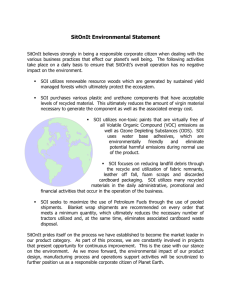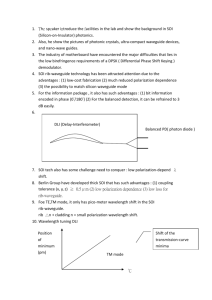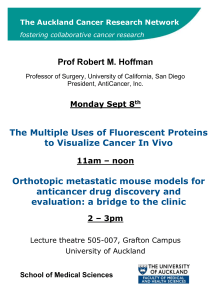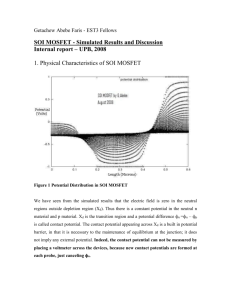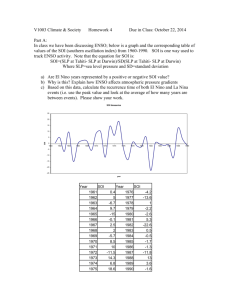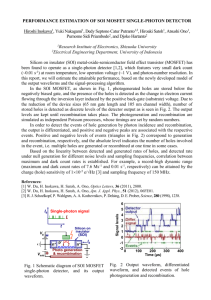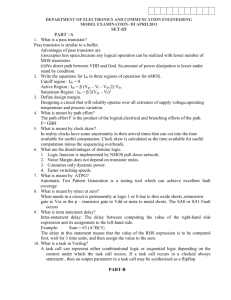Lecture23 slides - Department of Electrical Communication
advertisement
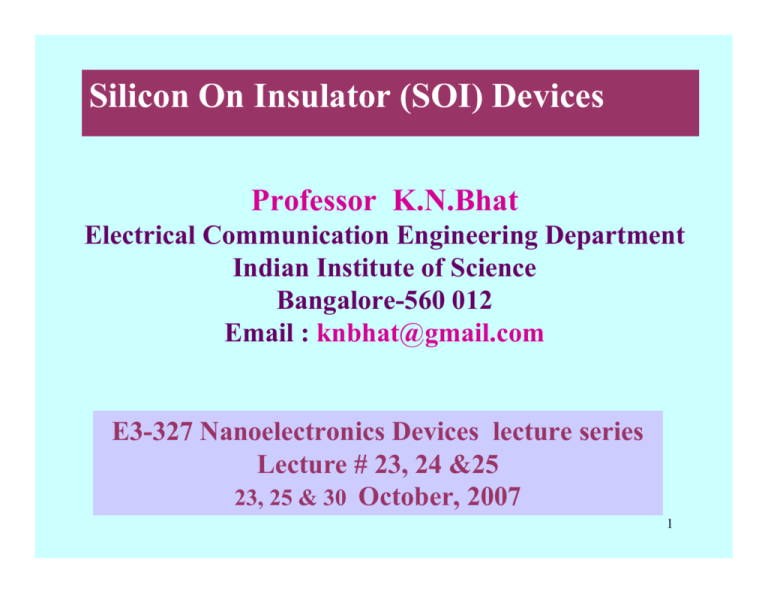
Silicon On Insulator (SOI) Devices Professor K.N.Bhat Electrical Communication Engineering Department Indian Institute of Science Bangalore-560 012 Email : knbhat@gmail.com E3-327 Nanoelectronics Devices lecture series Lecture # 23, 24 &25 23, 25 & 30 October, 2007 1 Outline • SOI concept and Technologies • SOI - Partially Depleted (PD) and Fully Depleted (FD) SOI MOSFETs • Ultra Thin (UT) Body SOI - Double gate (DG) Transistors , Integration issues • Vertical Transistors - Fin FET and Surround gate FET 2 Bulk silicon and Silicon on Insulator (SOI) MOSFET 1. Bulk Silicon MOSFET Source Gate Drain N+ P N++ 2. SOI MOSFET Source Front Gate Drain P N+ N+ (100) Silicon (100) Silicon Back Gate Bulk Silicon wafer (cross section) SOI wafer (cross section) SOI Layer BOX (100) Bulk silicon wafer Silicon substrate 3 SOI MOSFET Structure S N+ Gate Oxide D G1 P N+ Buried OXide Substrate G2 Floating silicon film: Æ Floating Body Effects 4 SOI Technologies ¾ SOS (Silicon-On-Sapphire) ¾SIMOX (Separation by IMplanted OXygen) ¾ BESOI (Bond and Etch-back SOI) ¾ Smart- Cut® ¾ ELTRAN® (Epitaxial Layer TRANsfer) 5 Silicon-On-Insulator (SOI) Structures 1. Silicon-On-Sapphire (SOS) (100) Silicon (0112) Sapphire (Al2O3) Low channel electron mobility is observed in SOS MOSFETs (≈ 230-250 cm2/V-sec) 6 2.Separation by Implanted Oxygen (SIMOX) Wafer Process Oxygen implant at: Anneal in inert ambient -Energy 120-200 keV -Dose ~0.3-1.8e18 cm-2 above 1300°C, 3-6 hours SOI BOX Substrate • Multiple implants often reduce defect density • Typical BOX thickness: 100, 200, 400 nm • SOI film thickness varies from ~50 - 240 nm 7 3. Bonded and Etch back SOI process Thermally Oxidize Wafer-A Bond wafer -B on the oxide by SFB B Etch back the top wafer to the required SOI thickness SOI BOX A BOX BOX A A Silicon Fusion Bonding (SFB) is done in two steps : (1) Press the two hydrophilic wafers at low temperature (400 °C ) –OH bonding due to Vanderwal force.(2) Anneal ~1100°C to drive ‘H’ out and strengthen the bond by Si-O-Si bonding 8 4. Smart- Cut® process Hydrogen implantation through thermal oxide dose ~1-5e16 cm-2 BOX A H2 peak At ~400-600°C wafer A separates from B at H2 peak B B BOX BOX A Handle wafer B is bonded A After low temperature splitting, SOI wafer (B) is annealed ~1100°C to strengthen the bond, whereas wafer A is reused. SOI film thickness set by H2 implant energy and BOX thickness 9 5. 5 10 Bulk Silicon MOSFET Source Gate Drain N++ N+ SOI MOSFET Source Front Gate Drain P N+ N+ P Back Gate Benefits of SOI MOSFET : Low drain / source junction Capacitances and leakage currents Ability to operate in harsh environments (high temperature and high radiation dose rate) 11 SOI CMOS: Capacitance Advantage B A Junction Field oxide Junction Buried oxide Field Implant Substrate Substrate Junction capacitance: smaller than in bulk 12 CMOS - Bulk vs. SOI Bulk CMOS structure 13 SOI CMOS structure 14 SOI CMOS: Latch-up advantage latch-up free operation IN GND P+ VD OUT N+ N+ IN P+ N-well P+ N+ GND N+ VD OUT P N+ P+ N P+ P-substrate N-Channel Bulk CMOS P-Channel SOI CMOS 15 Advantages of SOI CMOS • Technology – Simpler technology with no wells or trenches • Device performance – Better dielectric isolation in both vertical and horizontal directions – No latch up – Better radiation tolerance 16 Advantages of SOI CMOS • Device performance – Reduced sub-threshold swing (S) – allows lower voltage operation dVGS S= d [log I D ] Ideal value of ‘S’=60mV/decade 17 Advantages of SOI CMOS Technology over bulk CMOS ¾ Latch up free CMOS Technology ¾ Low parasitic capacitances : drain / source junctions and interconnects ¾ Ability to operate in harsh environments (high temperature and high radiation dose rate) ¾ Low voltage operation - Ideal subthreshold slope 18 Common types of SOI MOSFET 19 Partially Depleted SOI MOSFET tSi < 2 x d (max) +VGf VDS Front gate oxide xd (max) t Si N+ Depleted P-type neutral xd (max) Depleted N+ BOX P-Substrate +VGb The basic device equations of PD SOI MOSFETs are the same as for bulk devices, except of course from the complications arising from the floating body (FBE)20 Fully Depleted SOI MOSFET (thin SOI film ) +VGf VDS Front gate oxide P-type Depleted SOI layer N+ x d (max) t s t<Sixd<(max) BOX N+ •In FDSOI case, the front and back channels are electro-statically coupled during device operation P-Substrate VGb = 0 or +ve •This electrostatic coupling, makes the front channel FD device parameters dependent on the back gate voltage, including drain current, threshold voltage, 21 sub-threshold slope etc Energy Band diagrams of (A)Bulk, (B) Partially Depleted (PD) SOIMOSFET and (C)Fully Depleted (FD) SOI MOSFETs A B Gate oxide Ec Ec Ef Ef Ev Ev C Ec Front gate oxide Ef Ev Back gate oxide Shaded regions are depleted Front gate oxide Back gate oxide 22 FD SOI Device operation and Threshold Voltage analysis Front Gate VGf VD tOxf Front channel n+ p tSi n+ tOxb Back channel P+-Substrate VGb Back Gate 23 FD MOSFET: Operation Modes VG1 Front Inversion Back Accumulation Front Inversion Back Depletion Front Inversion Back Inversion Front Depletion Back Accumulation Front Depl. Back Depl. Front Depletion Back Inversion Front Accumulation Back Accumulation Front Accum. Back Depl. VG2 Front Accumulation Back Inversion 24 Electric field and Potential distribution E Front surface is always in inversion A – Back surface is in accumulation B – Back surface is in depletion C – Back surface is in inversion 00 2φB 2φB 0 25

